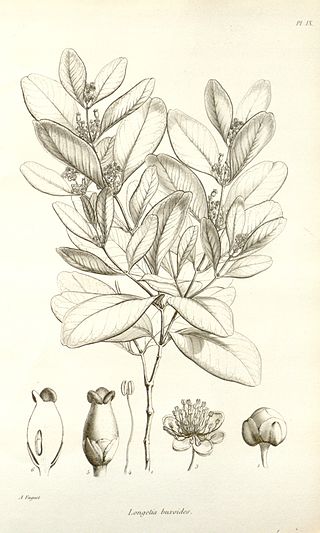
Edward Tuckerman was an American botanist and professor who made significant contributions to the study of lichens and other alpine plants. He was a founding member of the Natural History Society of Boston and most of his career was spent at Amherst College. He did the majority of his collecting on the slopes of Mount Washington in the White Mountains of New Hampshire. Tuckerman Ravine was named in his honor. The standard botanical author abbreviation Tuck. is applied to species he described.
Philyra is a plant genus of the family Euphorbiaceae first described as a genus in 1841. It contains only one known species, Philyra brasiliensis, native to Brazil, Paraguay, and northeastern Argentina.
Cephalocroton is a genus of plant of the family Euphorbiaceae first described as a genus in 1841. It is native to central, eastern, and southern Africa from Nigeria and Ethiopia south to KwaZulu-Natal.
Choriceras tricorne is a species of plants under the family Picrodendraceae and one of two species in the genus Choriceras. It is found in Southern New Guinea and Australia.
Kairothamnus is a genus of plants under the family Picrodendraceae described as a genus in 1980. The only known species is Kairothamnus phyllanthoides, endemic to Morobe Province in Papua New Guinea.
Actinostemon is a plant genus of the family Euphorbiaceae first described as a genus in 1841. It is native to South America, Central America, and the West Indies.

Longetia is a genus of plants under the family Picrodendraceae first described as a genus in 1866. It has only one known species, Longetia buxoides, endemic to New Caledonia.

Micrantheum is a genus of plants under the family Picrodendraceae described as a genus in 1818. It is endemic to Australia.
- Micrantheum demissumF.Muell. - South Australia
- Micrantheum ericoidesDesf. - New South Wales, Queensland
- Micrantheum hexandrumHook.f. - Box Micrantheum - New South Wales, Queensland, Victoria, Tasmania
- Micrantheum serpentinumOrchard - Western Tridentbush - Tasmania

Pseudanthus is a genus of plants under the family Picrodendraceae. The genus is endemic to Australia described as a genus in 1827.
Aristogeitonia is a plant genus in the family Picrodendraceae, described as a genus in 1908. It is native to Africa and Madagascar.
- Aristogeitonia gabonica - Gabon
- Aristogeitonia limoniifolia - Angola
- Aristogeitonia lophirifolia - Madagascar
- Aristogeitonia magnistipula - Tanzania
- Aristogeitonia monophylla - Tanzania, Kenya
- Aristogeitonia perrieri - Madagascar
- Aristogeitonia uapacifolia - Toliara Province
Voatamalo is a plant genus in the family Picrodendraceae first described as a genus in 1976.
Picrodendron is a genus of plant in the family Picrodendraceae, described in 1859. It contains one species, Picrodendron baccatum, native to the West Indies.
Discocarpus is a genus of the plant family Phyllanthaceae first described as a genus in 1841. It is native to northern South America. It is dioecious, with male and female flowers on separate plants.
- Discocarpus essequeboensisKlotzsch - Brazil, Venezuela (Amazonas), Guyana, Suriname, French Guiana
- Discocarpus gentryiS.M.Hayden - S Venezuela (Amazonas), Peru (Loreto), N Brazil
- Discocarpus pedicellatusFiaschi & Cordeiro - State of Bahia in Brazil
- Discocarpus spruceanusMüll.Arg. - Venezuela (Amazonas), Brazil, Suriname (Sipaliwini), Bolivia
Johann Friedrich Klotzsch was a German pharmacist and botanist.

Picrodendraceae is a family of flowering plants, consisting of 80 species in 24 genera. These are subtropical to tropical and found in New Guinea, Australia, New Caledonia, Madagascar, continental Africa, and tropical America. Its closest relatives are Phyllanthaceae.

Bia is a genus of plant of the family Euphorbiaceae first described as a genus in 1841. The entire genus is native to South America.
- Bia alienataDidr. - Brazil, Bolivia, Paraguay, N Argentina
- Bia capivarensisMedeiros & Alves - Serra da Capivara
- Bia fallax(Müll.Arg.) G.L.Webster - Peru, Rondônia
- Bia fendleri(Müll.Arg.) G.L.Webster - Guyana, Venezuela, Amazonas State of Brazil
- Bia lessertianaBaill. - Fr Guiana, Suriname, Guyana, N Brazil
- Bia manueliiV.W. Steinm. & Ram.-Amezcua, 2013, Sierra de Coalcomán, Michoacán, Mexico

Astraea is a plant genus of the family Euphorbiaceae first described as a genus in 1841. It is native to tropical regions of the Western Hemisphere.

Stachystemon is a plant genus in the family Picrodendraceae first described as a genus in 1845.







